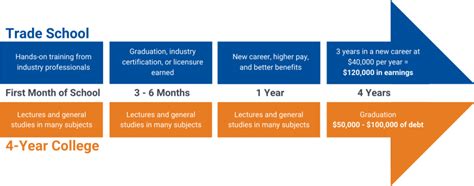Navigating the Journey Towards Skilled Trades Mastery
For individuals seeking a career path in the hands-on realm of skilled trades, understanding the duration of trade school is crucial. This article provides a comprehensive overview of the time commitment involved in obtaining a trade school education, exploring factors that influence the length of programs and offering insights into the various options available.

Factors Influencing Program Duration
The duration of trade school programs varies depending on several factors, including:
-
Type of Trade: Different trades require varying levels of skill and knowledge, leading to variations in program length. For example, electrical programs typically take longer than carpentry programs.
-
Program Level: Trade schools offer programs at different levels, from certificate programs to associate’s degrees. Certificate programs are shorter, while associate’s degrees require more coursework and typically take longer to complete.
-
School Schedule: Trade schools offer programs on various schedules, including full-time, part-time, and evening classes. Part-time and evening programs extend the overall duration of the program due to reduced class hours per week.
Program Lengths and Education Levels
Certificate Programs:
- Duration: Typically range from 6 months to 2 years, depending on the trade and certification level.
- Education Level: Entry-level training, providing foundational skills and knowledge.
- Examples: Basic electrical wiring, plumbing repair, welding techniques.
Associate’s Degree Programs:
- Duration: Typically take 2-3 years of full-time study to complete.
- Education Level: Advanced training, providing comprehensive theoretical and practical skills.
- Examples: Electrical technology, HVAC-R, culinary arts.
Common Mistakes to Avoid
When considering trade school, it’s important to be aware of common mistakes to avoid:
- Underestimating Time Commitment: Failing to account for the full length of the program can lead to unforeseen delays and financial setbacks.
- Choosing a Program Not Aligned with Career Goals: Selecting a trade program based solely on time constraints may not align with individual interests or career aspirations.
- Neglecting Prior Research: Insufficient research into schools, programs, and industry demand can result in dissatisfaction and potential career changes.
Pros and Cons of Trade School
Pros:
- Hands-on Training: Emphasis on practical skills, providing valuable experience for real-world applications.
- Career Advancement: Specialized training opens doors to higher-paying positions and career advancement opportunities.
- Job Security: Skilled trades professionals are in high demand, leading to stable and fulfilling careers.
Cons:
- Limited Educational Flexibility: Trade school programs focus on specific skills, limiting the scope of education compared to traditional universities or colleges.
- Physical Demands: Many trades involve physically demanding tasks, which may not be suitable for everyone.
- Stigma: Misconceptions about trade school as “lesser than” can affect social and professional perceptions.
Conclusion
The duration of trade school varies depending on the type of trade, program level, and school schedule. By carefully considering the factors influencing program length and avoiding common mistakes, individuals can make informed decisions about their trade school journey. With a commitment to education and mastery, trade school graduates can embark on rewarding and fulfilling careers in the skilled trades industry.
